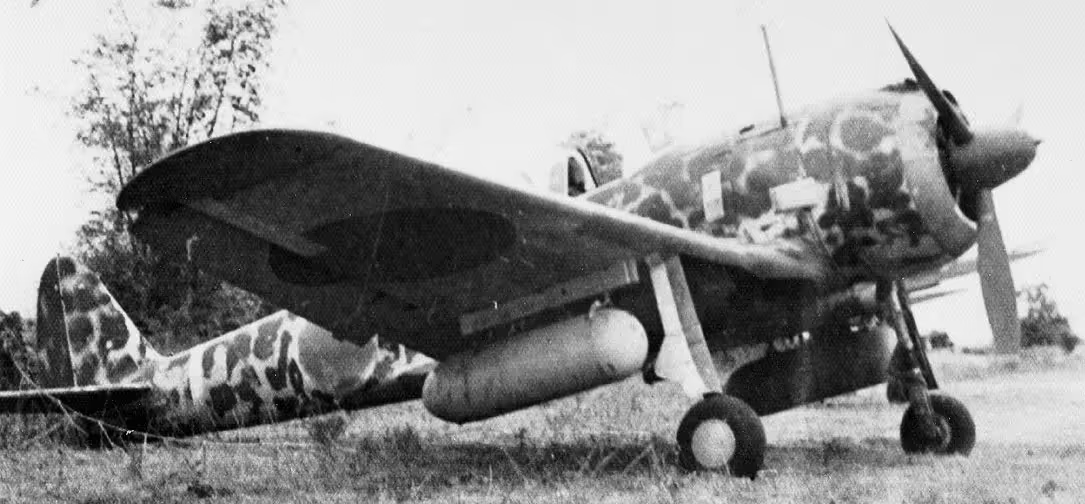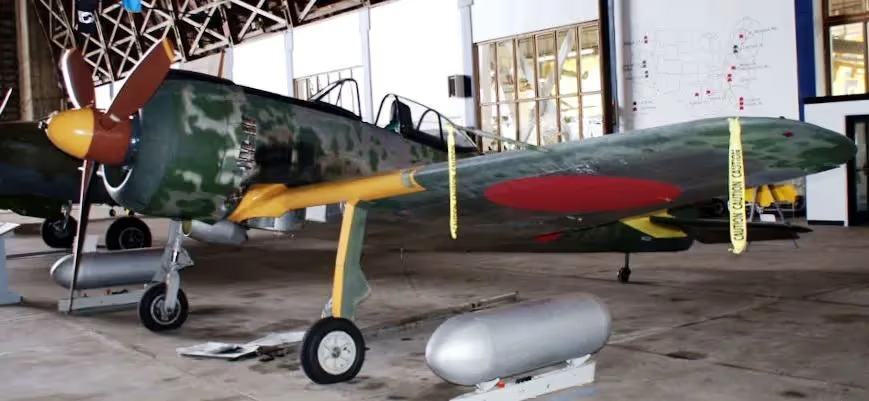Warplanes of Japan: Nakajima Ki-43 Hayabusa
Nakajima Ki-43 Hayabusa

(SDASM Photo)
The Nakajima Ki-43 Hayabusa (隼, "Peregrine falcon"), formal Japanese designation Army Type 1 Fighter (一式戦闘機, Ichi-shiki sentōki) is a single-engine land-based tactical fighter used by the Imperial Japanese Army Air Service in the Second World War. The Allied reporting name was "Oscar", but it was often called the "Army Zero" by American pilots because it bore a certain resemblance to the Mitsubishi A6M Zero, the Imperial Japanese Navy's counterpart to the Ki-43. Both aircraft had generally similar layout and lines, and also used essentially the same Nakajima Sakae radial engine, with similar round cowlings and bubble-type canopies (the Oscar's being distinctly smaller and having much less framing than the A6M).
While relatively easy for a trained eye to tell apart with the "finer" lines of the Ki-43's fuselage – especially towards the tail – and more tapered wing planform; in the heat of battle, given the brief glimpses and distraction of combat, Allied aviators frequently made mistakes in enemy aircraft identification, reportedly having fought "Zeros" in areas where there were no Navy fighters.
Like the Zero, the radial-engined Ki-43 was light and easy to fly and became legendary for its combat performance in East Asia in the early years of the war. It could outmaneuver any opponent, but did not initially have armor or self-sealing fuel tanks, and its armament was poor until its final version, which was produced as late as 1945. Allied pilots often reported that the nimble Ki-43s were difficult targets but burned easily or broke apart with few hits.Total production amounted to 5,919 aircraft. Many of these were used during the last months of the war for kamikaze missions against the American fleet. (Wikipedia)

(SDASM Photo)
The Nakajima Ki-43 Hayabusa.
.avif)
(IJAAF Photo)
Nakajima Ki-43-II Hayabusa fighter.

(IJAAF Photo)
Second Lieutenant Toshio Anazawa of Army Special Attack Unit (20th Shinbu party) piloting an Army Type 1 fighter "Hayabusa" III- type-Ko holding a 250kg bomb, departing for Okinawa on 12 April 1945.

(IJAAF Photo)
In combat, the Hayabusa was superior to any opposing fighter it encountered in the initial part of the war. The OSCAR remained formidable even as more experienced Allied pilots and better aircraft entered the fray. Like the Zero, the OSCAR turned and stalled better than most fighters to see combat in the war. Low gross weight was an important factor in this performance. Nakajima achieved it by building a spare, tidy airframe powered by a relatively small engine. The company only installed two machine guns, and omitted pilot armor and self-sealing gas tanks. These sacrifices cost dearly when the Allies began to field airplanes with heavy firepower such as the Lockheed P-38 Lightning. The Lightning packed four 12.7 mm (.50 cal) machine guns and a 20 mm cannon. Many P-38 pilots commented on the tendency of OSCARs to explode after only a short burst of fire. The small engine propelling the K-43 also limited performance for it permitted Allied pilots flying faster airplanes to engage or decline combat at their discretion. (Smithsonian Instution)
_PDVD_005.avif)
(IJAAF Photo)
Nakajima Ki-43 from "Kato hayabusa sento-tai (Colonel Kato's Falcon Squadron)". The “Hayabusa” was the most common (and deadly) adversary for the Allied pilots during the Malayan campaign. Pilots flying the Ki-43 shot down more Allied aircraft than in any other Japanese fighter. And almost all the JAAF’S aces achieved most of their kills in it.

(IJAAF Photo)
Nakajima Ki-43 Hayabusa fighters.
.avif)
(SDASM Photo)
Nakajima Ki-43-II Hayabusa fighter.

(USAAF Photo)
A captured Ki-43 in USAAF markings, guarded by MP’s at Clark Field, Philiipines.
Surviving Nakajima Ki-43 Hayabusa fighters

(Articseahorse Photo)
750 – Ki-43-I on display at Flying Heritage Collection in Everett, Washington. Former ZK-OSC restored to flying conditionby the Alpine Fighter Collection in the 1990s, not currently flying.
5465 – Ki-43-II displayed unrestored at the Australian War Museum in Canberra,Australian Capital Territory. The nose and tail are in the main museumbuilding, while the wings and center section are in storage.


(Author Photos)

(Stumanusa Photo)

(aeroprints.com Photo)

(Stumanusa Photo)

(Sekinei Photo)
6430 – Ki-43-IIb on display at the Pima Air & Space Museum in Tucson, Arizona. This aircraft was previously on display at the EAA Air Venture Museum and the Museum of Flight and is on loan from the National Air and Space Museum.

(Goshimini Photo)
Reproduction – Ki-43-IIIa on display at the Museum of Flight in Seattle, Washington. This aircraft contains parts from four different wrecks. The restoration was begun by the Texas Airplane Factory and completed by GossHawk Unlimited.
.avif)
.avif)
(Valder137 Photos)
Reproduction – Ki-43-IIIa at the Erickson Aircraft Collection in Madras, Oregon. This aircraft was previously at the Tillamook Air Museum in Tillamook, Oregon.
Reproduction – Ki-43 originally under restoration/rebuild at Texas Airplane Factory, Meacham Field, Fort Worth, Texas from 4 wrecks. Now located at GossHawk Unlimited in Casa Grande, Arizona.
Reproduction – Ki-43 originally under restoration/rebuild at Texas Airplane Factory, Meacham Field, Fort Worth, Texas. Now located at GossHawk Unlimited in Casa Grande, Arizona.

(Z3144228 Photo)

(STA3816 Photo)
Reproduction – Ki-43 on display outside Chiran Peace Museum for Kamikaze Pilots, Minamikyūshū, Kagoshima, Japan.
Unknown msn – Ki-43 awaiting restoration at The Fighter Collection in Duxford, United Kingdom. The aircraft is currently undergoing restoration by NobuoHarada and will be placed on display at the Kawaguchiko Motor Museum when completed.
Unknown serial number – Ki-43 on display at Dirgantara Mandala Museum in Yogyakarta.
.avif)

(ワグナス Wagunasu Photos)
Unknown serial number – Ki-43 under restoration at the Kawaguchiko Motor Museum/ Fighter Museum in Kawaguchiko, Yamanashi.
_%25E2%2580%2593_Victory_Park%252C_Moscow_(37931820205).avif)
_%25E2%2580%2593_Victory_Park%252C_Moscow_(24946036498).avif)
(Alan Wilson Photos)
Nakajima Ki-43-IIB Hayabusa reconstruction from the wreckage recovered from a crash site. Rebuilt with many new parts to form a complete airframe, on display in ‘Victory Park’, Museum of the Great Patriotic War, Poklonnaya Hill, Moscow, Russia.















Nakajima Ki-43-II Hayabusa, code-named Oscar, IJAAF. (IJAAF Photos)

Nakajima Ki-43-I Hayabusa, XJ002, Brisbane, Queensland, Australia in 1943. After its capture at Hollandia in New Guinea, it was rebuilt by the Technical Air Intelligence Unit (TAIU) in Hangar 7 at Eagle Farm, Brisbane, Australia. (USAAF Photo)




Nakajima Ki-43-II Hayabusa codenamed "Oscar", TAIU-SWPA, XJ004, "Racoon Special", Hollandia and Australia. This aircraft was shipped to the USA, arriving at NAS Alameda, California. Its ultimate fate is unknown. (USAAF Photos)




Nakajima Ki-43-II Hayabusa codenamed "Oscar", TAIU-SWPA, XJ005, 84th Aerodrome Squadron. This aircraft was shipped to the USA, arriving at NAS Alameda, California. Its ultimate fate is unknown. (USAAF Photos)

Nakajima Ki-43 Hayabusa, codenamed "Oscar", post-war. (USAAF Photo)

Nakajima Ki-43 Hayabusa, codenamed Oscar, possibly XJ002, Ki-43-II XJ004 or Ki-43-II XJ005 wearing USAAF markings post war in the USA. One came to the USA, Ki-43 (Serial No. 6430), designated USAAF FE-6430. This aircraft was on display in the EAA Museum, Oshkosh, Wisconsin. It is currently displayed in the Pima Air & Space Museum, Tucson, Arizona. (USAAF Photo)

(Stumanusa Photo)
Nakajima Ki-43 Hayabusa (Serial No. 6430), designated USAAF FE-6430, on display in the Pima Air and Space Museum, Arizona.



Nakajima Ki-43 II, P-5017, Chinese Air Force post war. (Chinese Air Force Photos)

(Ogrebot Photo)

(STA3816 Photo)
Nakajima Ki-43 Hayabusa on display in the Chiran Peace Museum for Kamikaze Pilots, Minamikyushu, Kagoshima, Japan.

Nakajima Ki-43 Hayabusa on display in the Museum Dirgantara Udara Yogyakarta, Indonesia. (Davidelit Photo)



(Articseahorse Photos)


(John Veit Photos)
Nakajima Ki-43-I Hayabusa (Serial No. 750), codenamed "Oscar" was found in dense jungle 6 km from Vunakanau airfield, Rabaul, in September 1945. This plane entered service in January 1943 and went to Truk as part of the 1st and 11th Sentai. Later it was moved to serve at Rabaul, New Britain. The plane had severe front-end damage from its final landing, but was repaired by Japanese servicemen with parts salvaged from a number of other Ki-43s. It was then forwarded to Australia for the Australian War Memorial. It was sold in 1954 to New Zealand and is today (airworthy) on display at the Flying Heritage Collection, Everett, Washington.




(Valder137 Photos)
Nakajima Ki-43-IIb Hayabusa (Oscar), Tillamook, Oregon.


(Articseahorse Photos)

(Goshimini Photo)
Nakajima Ki-43-IIb, Seattle Museum of Flight, Seattle, Washington


(Alan Wilson Photos)


(Mike1979 Russia Photos)
Nakajima Ki-43 Hayabusa. This aircraft was rebuilt using the remains from a crash site. The wing, engine and prop, at least, are genuine. It wears the markings of the 54th Sentai, which it served with on Shumshu island. Museum of the Great Patriotic War, Victory Park, Moscow.
Nakajima Ki-43 Hayabusa, owned by The Fighter Collection, Duxford, England and awaiting restoration.
Nakajima Ki-43-II Hayabusa, currently on display at the Museum Dirgantara Udara Yogyakarta.
Former ZK-OSC restored to flying condition by the Alpine Fighter Collection in the 1990s, not currently flying.
Nakajima Ki-43-IIIb, four aircraft are under restoration/rebuild at the Texas Airplane Factory, Meacham Field, Fort Worth, Texas.





